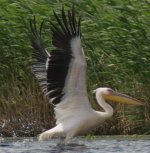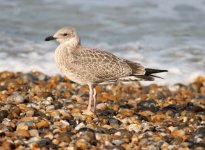-
Welcome to BirdForum, the internet's largest birding community with thousands of members from all over the world. The forums are dedicated to wild birds, birding, binoculars and equipment and all that goes with it.
Please register for an account to take part in the discussions in the forum, post your pictures in the gallery and more.
You are using an out of date browser. It may not display this or other websites correctly.
You should upgrade or use an alternative browser.
You should upgrade or use an alternative browser.
Gull (1 Viewer)
- Thread starter lou salomon
- Start date
More options
Who Replied?lou salomon
the birdonist
Frenchy said:Yep, thats a big bill. And a pink leg? I'm no gull expert Lou, but how do you rule out argentatus on these views (not including range)?
long bill with pointed tip and weak gonys angle plus p10 pattern which in the last pic (the one with the 'impressive bill') shows well. i mean the underside of p10-tip. you have this characteristic caspian pattern: large white tip (though broken by a subterminal band in this case, usually all white in ponticus,the western race), then a narrowish black band and then again light coloured inner fan. that's caspian.
see http://www.surfbirds.com/cgi-bin/gallery/display.cgi?gallery=gallery12&start=37 (go to the rutland waters adult caspian, 4/7/06 by matthew berriman).
edit: gape looks to bright red (though not deep red) for argentatus either, and of course, photographed in summer time in the core danube delta. sorry to repeat this - but i suspect the pigmentation of iris and legs to be weak due to its illness (see bill base). so the usually yellowish feet are pink here - but i've seen pink legs in healthy ad summer also...
cheers
Last edited:
London Birder
Well-known member
looks like juv LBB to me
lou salomon
the birdonist
agreed. graellsii.
jforgham
Birding for fun
lou salomon said:agreed. graellsii.
I thought this too, but not given as this on the website from which I took the photo. South UK yesterday.
lou salomon
the birdonist
so, as what was it given then, jono? which site?
jforgham
Birding for fun
lou salomon said:so, as what was it given then, jono? which site?
Check this http://www.dungenessbirdobs.org.uk/lateframe.html
What views now and why did David Walker come up with this id? He certainly knows his gulls
lou salomon
the birdonist
hm hm hm, it makes me uncertain. juv ylg are quite similar to lbbg i guess and this ind. has longish legs...got to check further. :h?:
edit: well, juvenile plumaged big gulls are hard. overall colour seems a bit too warm brown for LBBG but it could be the bright light. on structure it could be well a female YLG. a bit lighter forehead and belly seems in line with YLG too but is sure within the variation of juv LBBG. no signs of moult in scaps which is in favour of LBBG, but if bread in a northerly part of europe (holland or so) it's ok with YLG too i think. lets see what jan says about this.
edit: well, juvenile plumaged big gulls are hard. overall colour seems a bit too warm brown for LBBG but it could be the bright light. on structure it could be well a female YLG. a bit lighter forehead and belly seems in line with YLG too but is sure within the variation of juv LBBG. no signs of moult in scaps which is in favour of LBBG, but if bread in a northerly part of europe (holland or so) it's ok with YLG too i think. lets see what jan says about this.
Last edited:
London Birder
Well-known member
lou salomon said:agreed. graellsii.
ID of bird in question aside Lou ... what's the best way of doing graellsii from intermedius type birds at this age?
lou salomon
the birdonist
rings on their legs, des. due to much variation and clinal characteristics between graellsii and intermedius i'd say it's almost impossible ti id a juv intermedius for certain in england. intermedius is the biggest taxon, and sometimes shows fuscus-like features, so maybe the belly is tendentially lighter than in graellsii. maybe jan has a better answer, but i suppose he will be as cautious as always 
London Birder
Well-known member
thanks for that Lou, as tricksy as I suspected.
Frenchy
Well-known member
Gulls. Don't you just love 'em....
I'm just a luddite, but i find the attempted ID of loads of the LWHG complex a bit pointless. Half the time, you never actually KNOW if you've got to the right ID, as there is just so much variation, overlap and hybridization. I've seen 1st win argentatus with more extensively dark tails than many smithsonianas, and how the hell would you pick out an adult smicker in Europe that was 100% not an argentatus? :h?:
I'm going to look at some eastern phylloscs. At least they call... :t:
I'm just a luddite, but i find the attempted ID of loads of the LWHG complex a bit pointless. Half the time, you never actually KNOW if you've got to the right ID, as there is just so much variation, overlap and hybridization. I've seen 1st win argentatus with more extensively dark tails than many smithsonianas, and how the hell would you pick out an adult smicker in Europe that was 100% not an argentatus? :h?:
I'm going to look at some eastern phylloscs. At least they call... :t:
gerdwichers8
Well-known member
Well, I m not of much use here: I get stuck already in the O&L book itself.
We only get lots of LBBG intermedius but thats the only one
We only get lots of LBBG intermedius but thats the only one
jforgham
Birding for fun
[lets see what jan says about this.[/QUOTE]
Hi Lou,
Thanks for the breakdown for id purposes, most useful.
Whilst on the subject of Jan, thought his PC was set up with an alarm that went off the second somebody typed in gull. Must be away at present. Interesting to hear his views , too
Hi Lou,
Thanks for the breakdown for id purposes, most useful.
Whilst on the subject of Jan, thought his PC was set up with an alarm that went off the second somebody typed in gull. Must be away at present. Interesting to hear his views , too
Last edited:
lou salomon
the birdonist
there you go, he's lurkin'!
lou salomon
the birdonist
one of the many contradictory statements in olsen’s “gulls” is about iris colour in western versus eastern cachinnans: “in ukrainean breeders, eyes pale in 55%, medium in 28% and dark in 17%” (now these are western birds – the so called ponticus!) the immediate following phrase: “seemingly a larger percentage of pale-eyed birds towards the E of breeding range.” and later, in ‘geografical variation’ it says about ponticus: “a larger percentage shows paler eyes (pers. obs. UAE)” !!!
hm
hm
JANJ
Well-known member
Hi all, had to have some coffee, been out chasing juv. Pallid Harrier today on Öland.
Lou´s gull, is moulting it´s head which gives the bill/head proportions a different look, bill looks more huge than it perhaps actually is. No doubt a male, and I can by a Caspian, even if it has a yellowish orbital ring and a pale iris, which som has, but usually the orbital ring has some reddish, but perhaps more in dark-eyed birds. p10 looks good for Caspian, but see here:
http://www.xs4all.nl/~daarruud/polen2/argentatus5cy.html
Quite easy to confuse sometimes, the juvenile gull looks more like a LBBG. A quick look at the tail reveals a broad dark tail band, not consistent with YLG. Also the pale looking uniform head pattern, with no obvious dark ear-patch and somehow structure of the bird doesn´t ring a YLG bell to me, instead I think it´s a LBBG.
http://www.gull-watching.com/photo-127433-dsc05738_jpg.html
and again:
http://www.xs4all.nl/~daarruud/michahellis.html
About the comments Lou, about iris colour in eastern versus western Caspian, I think that it´s partly lack of knowledge, we know less about these ssp/forms than what usually might be belived
JanJ
Lou´s gull, is moulting it´s head which gives the bill/head proportions a different look, bill looks more huge than it perhaps actually is. No doubt a male, and I can by a Caspian, even if it has a yellowish orbital ring and a pale iris, which som has, but usually the orbital ring has some reddish, but perhaps more in dark-eyed birds. p10 looks good for Caspian, but see here:
http://www.xs4all.nl/~daarruud/polen2/argentatus5cy.html
Quite easy to confuse sometimes, the juvenile gull looks more like a LBBG. A quick look at the tail reveals a broad dark tail band, not consistent with YLG. Also the pale looking uniform head pattern, with no obvious dark ear-patch and somehow structure of the bird doesn´t ring a YLG bell to me, instead I think it´s a LBBG.
http://www.gull-watching.com/photo-127433-dsc05738_jpg.html
and again:
http://www.xs4all.nl/~daarruud/michahellis.html
About the comments Lou, about iris colour in eastern versus western Caspian, I think that it´s partly lack of knowledge, we know less about these ssp/forms than what usually might be belived
JanJ
Last edited:
Similar threads
- Replies
- 2
- Views
- 602
Users who are viewing this thread
Total: 2 (members: 0, guests: 2)





